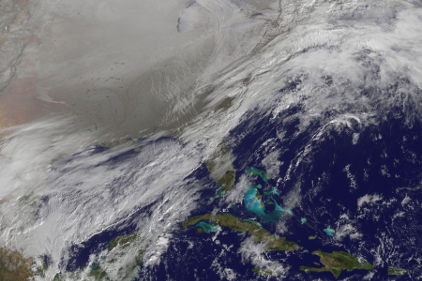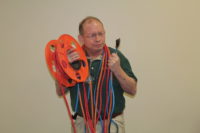Restoring Success: What the CAT Just Happened?
As we all know, in this business, sometimes you have days to get ready and sometimes minutes.

 Did this happen to you? Ring…ring…ring…ring, ring, ring! The phone rings. You can’t answer it fast enough?
Did this happen to you? Ring…ring…ring…ring, ring, ring! The phone rings. You can’t answer it fast enough?
Yes, records were set - the snowiest, the coldest and the most burst pipes? January 2014 proved to be vicious: Reports read:
Now the Big Question Is Whether This Is All Weather
“Record-low temperatures in December and January have also been cited by many economists as the primary driver of disappointment in a string of weaker-than-expected housing-related and labor-market economic data releases in recent weeks, including the most recent release of the widely followed monthly jobs report prepared by the U.S. Bureau of Labor Statistics, which pointed to a sharp slowdown in hiring in December.”
-Business Insider, Matthew Boesler, February 3, 2014
Flight Weather Disruptions in January Cost Americans $2.5 Billion
“January 2014 was the worst month for flight disruptions in recent history. An airline cost tracking group estimates that severe weather flight delays last month cost Americans $2.5 billion in lost business and productivity.”
-Carmen J. Cox, Feb 4, 2014
Polar Vortex may have Cost Economy about $5 billion
“Hunkering down at home rather than going to work, canceling thousands of flights and repairing burst pipes from the Midwest to the south-east has its price. By one estimate, about $5 (billion). The country may be warming up from the polar vortex, but the bone-chilling cold, snow and ice that gripped much of the country – affecting about 200 million people – brought about the biggest economic disruption delivered by the weather since superstorm Sandy in 2012, said Evan Gold, senior vice-president at Planalytics, a business weather intelligence company in suburban Philadelphia.”
-The Associated Press, January 10, 2014
So, the questions are: Were you ready? And are you ready for the next catastrophic (CAT) event? Whether it is more frozen pipes to come, a flood or hurricane, we need to be ready. We need to be ready to handle high call volumes and respond. We make commitments to respond when the disaster strikes.
How do you fare during these situations that are “moments of truth?” They are opportunities to develop new relationships, build your business and show what you are made of. Whether you have an action plan or still need to create one, we should always ask ourselves, “How did we do?” Make improvements to your existing plan or stop and make a plan. The following is a list of considerations for you:
· Phones: Call volume must be handled effectively and efficiently. The long-term effect from just not answering the phone is damaging. Prepare staff members who may not normally answer the phone to help. Establish resources to call in to assist during high call volumes.
· Human Resources: Establish a network that can assist you with basic water losses. Develop an abbreviated training program. Have a readily available list with contact information. Be proactive and notify them in advance of the pending event.
· Equipment and Supplies: Be prepared with your list of vendors who can provide you rental equipment and supplies. Develop these relationships. Check your inventories in advance of the CAT event coming your way. Have a protocol to check equipment to make sure it is all field ready.
· Managing Expectations: I believe this is of the utmost importance. The phone must be answered. Come up with a plan - a script - for those answering the phone to give your customers an honest and clear expectation. For example, “We typically respond to all emergencies within an hour, at this time, due to the nature of what our region is experiencing, we can have a crew out on Tuesday.” This simple step can help you succeed during this moment of truth. Be honest with your customers, this is appreciated. Giving unrealistic expectations and failing or not giving any type of concrete response can be a failure. Telling a customer who is in need of your service, no matter what the conditions, that you don’t know when you can arrive is not acceptable.
· Scheduling, Planning and Resource Management: This function needs to be of peak efficiency and effectiveness. We can’t tell a customer when we can arrive to assist, if we do not know ourselves. The command center needs to be strategic and concise. Deploying of equipment and staff must be at peak efficiency and broken down into regions within your coverage area. We also need to incorporate down time and rest for the team.
· Employee Morale: It is critical to keep the spirit and energy of the team up. Consider having nice meals available, massages and make sure everyone keeps smiling. Don’t let a cranky pants ruin the morale of everyone else. Don’t forget to thank the families of the team who usually have to make sacrifices of their own while their loved one works around the clock for days and sometimes weeks.
After every CAT experience, I encourage you to take a timeout and collect feedback from everyone in your company. What did you do well? What can we do better next time? Use this basic checklist as the start of a brainstorming session. You will discover others ways to tackle the next CAT situation even better. Make sure your plan is accessible and up to date so that everyone is ready to execute. As we all know, in this business, sometimes you have days to get ready and sometimes minutes.
Although many industries were adversely affected by the polar vortex, for restoration companies all over the country, this year started out to be one of the busiest winters in several years. All of this reminds me of a famous quote: “Luck is what happens when preparation meets opportunity.” Be prepared and make a great plan.
Looking for a reprint of this article?
From high-res PDFs to custom plaques, order your copy today!






